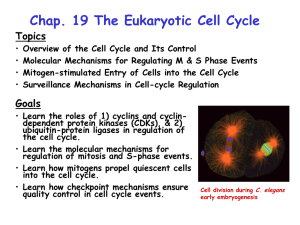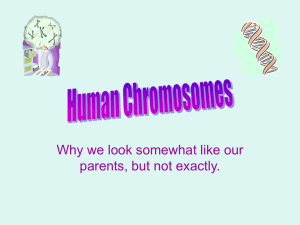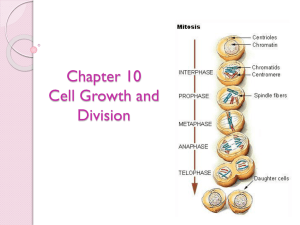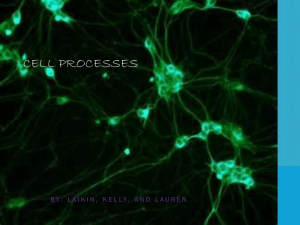Section 10–1 Cell Growth
advertisement
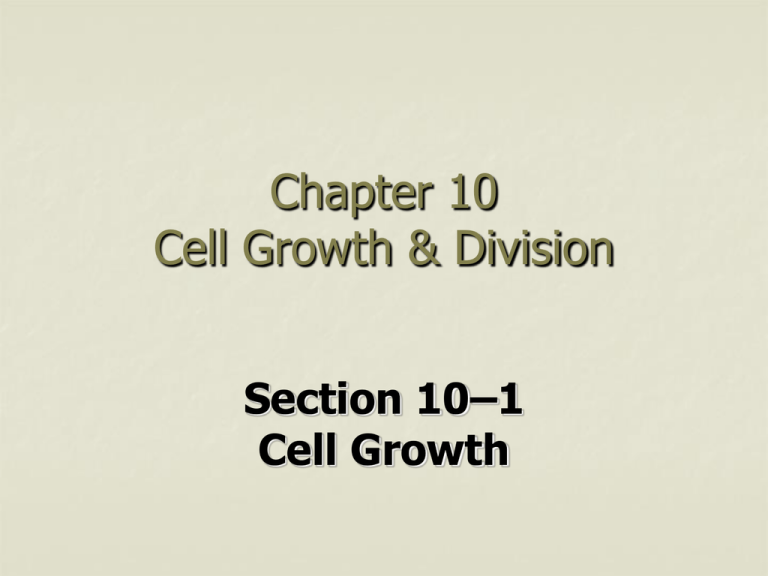
Chapter 10 Cell Growth & Division Section 10–1 Cell Growth Objectives What problems does growth cause for cells? Limits To Cell Growth Key Concept: The Larger A Cell Becomes, The More Demands The Cell Places On Its DNA And The More Trouble The Cell Has Moving Enough Nutrients And Waste Across The Cell Membrane DNA Overload Extra Copies Of DNA Are Not Made Like A Small Town – Infrastructure Needs To Grow As The Town Grows DNA Overload Exchanging Materials Cell Membrane (Surface Area) Nutrients Enter Waste And Products Leave The Amounts Of Nutrients Needed And The Amount Of Waste Produced Depends On The Cells Volume Ratio of Surface Area To Volume As Cell Size Increases Volume Increases More Rapidly Than Surface Area (cell membrane) Cell Membrane Can Not Cycle Nutrients and Wastes Fast Enough. Cell Division Cells Divide Before They Become To Large Cell Division Is The Process By Which A Cell Divides Into Two Daughter Cells Cell Division Before A Cell Divides It Replicates Its DNA So Each Cell Has An Exact Copy Chapter 10 Cell Growth & Division 10-2 Cell Division Objectives What are the main events of the cell cycle? What are the four phases of mitosis? Chromosomes Carry Genetic Information From One Generation of Cell to the Next Generation of Cells Made Up Of: DNA + Protein Chromosomes Every Organism Has A Specific Number Of Chromosomes Fruit Flys = 8 Carrots = 18 Humans = 46 Giraffe = 30 King Crab = 208 Chromosomes Not Visible Except During Division Well Before Division They Duplicate Chromosomes Chromatids Just Before Division Chromosomes Condense Into Compact, Visible Structures Called Chromatids Centromere Each Chromosome Has Two, Identical Chromatids Connected By A Centromere Chromosomes Chromatid A Kenitophore Copy of Chromatid A Centromere Microtubules or Spindle Fibers Chromatid A Copy of Chromatid A The Cell Cycle Key Concept: During The Cell Cycle: A Cell Grows Prepares For Division Divides To Form Two Daughter Cells Each Daughter Cell Then Begins The Cycle Again Cell Cycle Interphase Time In-Between Cell Divisions Cell Division or M phase Events Of The Cell Cycle Interphase May Be Quite Long Divided Into 3 Parts The 3 Parts of Interphase G1 Phase Cell Grows In Size Synthesize New Proteins & Organelles The 3 Parts of Interphase S Phase Chromosomes Are Replicated Once This Phase Begins The Cell Completes Division The 3 Parts of Interphase G2 Phase Organelles & Proteins Required For Mitosis Are Produced Cell Is Now Ready To Enter M Phase (Mitosis) Mitosis Key Concept: Biologists Divide The Events Of Mitosis Into Four Phases: 1. Prophase 2. Metaphase 3. Anaphase 4. Telophase Prophase 1st & Longest Phase Chromosomes Become Visible Centrioles Separate & Take Up Position On Opposite Sides Of The Nucleus Spindle Begins To Form Prophase In Animals Spindle Fibers Attach To Centromere On Each Chromatid In Plants No Centromere, Spindle Fibers Still Form From Centrosomes Late Prophase Nucleolus Disappears Nuclear Envelope Breaks Down Metaphase Short Just A Few Minutes Chromosomes Line Up Across Center Of The Cell Microtubules Connect The Centromere To The Poles Of The Spindle Anaphase Centromeres Separate Sister Chromatids Separate Each Set Of Chromosomes Pulled To Their Poles Telophase Chromosomes Disperse New Nuclear Envelopes Form Spindle Breaks Apart Nucleolus Reforms Cytokinesis There Are Now Two Nuclei In One Cell Cytokinesis Is The Division Of The Cytoplasm Into Two Cells The Cell Membrane Is Drawn Inward Until The Cell Pinches Into Two Equal Parts Cytokinesis In Plants A New Cell Plate Forms In The Middle Of The Cell Which Attaches To, And Becomes Part Of, The Cell Wall Chapter 10 Cell Growth & Division Section 10-3 Regulating Cell Growth Objectives How is the cell cycle regulated? How are cancer cells different from other cells? Controls On Cell Division When Cells In Cell Cultures Come In Contact With Each Other, They Stop Growing. Why? Controls On Cell Division If A Hole Is Made In The Cell Culture, Cell Growth Will Restart & Continue Until The Hole Is Filled. Why? Controls On Cell Division In Your Body The Rate Of Cell Growth Is Controlled. Injury Causes Rapid Division Until The Wound Is Healed. Then Division Slows Again. Why? Cell Cycle Regulators Key Concept: Cyclins Regulate The Timing Of The Cell Cycle In Eukaryote Cells. Discovered In The 1980’s Cyclins Are A Family Of Closely Related Proteins That Rise & Fall Within The Cell With The Cell Cycle Cyclins & Cell Cycle Cell Cycle Regulators Cyclins When Injected Into NonDividing Cells, Cyclins Cause Mitotic Spindles To Form. Cell Cycle Regulators Cyclins When Injected Into NonDividing Cells, Cyclins Cause Mitotic Spindles To Form. Cell Cycle Regulators Cyclins When Injected Into NonDividing Cells, Cyclins Cause Mitotic Spindles To Form. Cell Cycle Regulators Other Regulator Proteins Continue To Be Found. Other Internal Regulators These Proteins Respond To Events Inside The Cell. Several Make Sure The Cell Does Not Enter Mitosis Until All Chromosomes Have Been Replicated. Others Stop The Cell From Entering Anaphase Until All Chromosomes Are Attached To The Mitotic Spindle Cyclins & Cell Cycle External Regulators These Respond To Events Outside The Cell They Direct The Cell To Speed Up Or Slow Down The Cell Cycle These Include Growth Factors Growth Factors Very Active During Embryonic Development Wound Healing Other External Regulators Molecules On The Cell Membrane Of Neighboring Cells Slow The Growth Process They are like sensors that signal the cell to slow/stop growth Uncontrolled Cell Growth Uncontrolled Cell Growth Key Concept: Cancer Cells Do Not Respond To The Signals That Regulate The Growth Of Most Cells. As A Result, They Form Masses Of Cells Called Tumors That Can Damage Surrounding Tissue. Uncontrolled Cell Growth Metastasis Cancer Cells Break Loose From The Tumor And Invade Tissues Throughout The Body Some Carcinogen Sources Smoking Radiation Viral Infection p53 Gene Usually Stops The Cell Cycle Until Chromosomes Have Been Properly Replicated. High Percentage Of Cancers Cells Have Defects At This Gene Site







